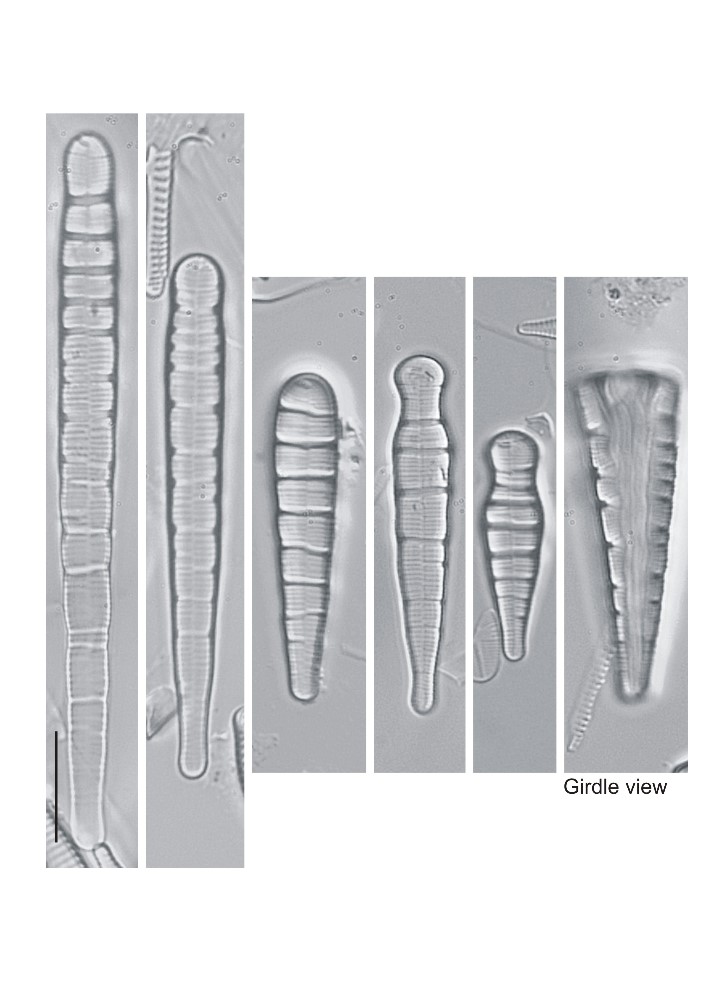Meridion C.A. Agardh; 1824; 14
Key references
Williams D.M. 1985. Morphology, Taxonomy and Inter-Relationships of the Ribbed Araphid Diatoms from the Genera Diatoma and Meridion (Diatomaceae: Bacillariophyta). Bibliotheca Diatomologica Vol. 8, J. Cramer, Vaduz. 228 pp.; 27 pls.
Williams D.M. 1990. Cladistic analysis of some freshwater araphid diatoms (Bacillariophyta) with particular reference to Diatoma and Meridion. Plant Systematics and Evolution. 171: 89-97.
Kociolek J.P., Liu Y., Wang X. 2011. Internal valves in populations of Meridion circulare (Greville) C.A. Agardh from the A’er Mountain region of northeastern China: Implications for taxonomy and systematics. Journal of Systematics and Evolution. 49: 486-494.
Morphology
Frustules distinctly wedged-shaped or linear in girdle view; attached either by mucilage from pore-fields, forming fan-shaped colonies (wedged-shaped species), or face to face by small spines on valve mantle margin (linear species).
Valves asymmetrical about the transapical axis, clavate; often with unevenly spaced striae, prominent transapical ribs, and narrow sternum.
Internally, transapical ribs as thickened virgae, narrow sternum not raised above valve surface.
Poles with simple pore fields, formed of reduced virgae and vimines.
Single rimoportula (sometimes 2) at broadest (head) pole in wedged-shaped species.
Valve mantle usually undulate, spines present either as reduced (small) stubs when non-linking or as interlocking extensions of virgae, when linking adjacent valves face to face.
Cingulum with 4 (5+) open bands, valvocopula with ornamentation, multiple rows of poroids on pars interior, single row on pars exterior, in wedge-shaped species, bands taper towards foot-pole. Copulae (including valvocopula) with ligula at one end fitting open part of adjacent band; valvocopula with very small septum.
Some (most?) species with internal valves (‘Innerschalen’), often with reduced transapical ribs.
When observed live, with many (8-12+) small plastids.
There are few species but many names. Most of the names are (probably) life cycle stages in the wedge-shaped species, Meridion circulare and Meridion constrictum, although it is doubtful that name represents one or two very widespread species.
Valves asymmetrical about the transapical axis, clavate; often with unevenly spaced striae, prominent transapical ribs, and narrow sternum.
Internally, transapical ribs as thickened virgae, narrow sternum not raised above valve surface.
Poles with simple pore fields, formed of reduced virgae and vimines.
Single rimoportula (sometimes 2) at broadest (head) pole in wedged-shaped species.
Valve mantle usually undulate, spines present either as reduced (small) stubs when non-linking or as interlocking extensions of virgae, when linking adjacent valves face to face.
Cingulum with 4 (5+) open bands, valvocopula with ornamentation, multiple rows of poroids on pars interior, single row on pars exterior, in wedge-shaped species, bands taper towards foot-pole. Copulae (including valvocopula) with ligula at one end fitting open part of adjacent band; valvocopula with very small septum.
Some (most?) species with internal valves (‘Innerschalen’), often with reduced transapical ribs.
When observed live, with many (8-12+) small plastids.
There are few species but many names. Most of the names are (probably) life cycle stages in the wedge-shaped species, Meridion circulare and Meridion constrictum, although it is doubtful that name represents one or two very widespread species.
Literature
References are given in chronological order.
Reference |
Citation |
|---|---|
| Agardh, C.A. 1824. Systema Algarum. Adumbravit C.A. Agardh. Lundae Literis Berlingianis. Lundae. xxxvii, 312 pp.. | Morphology; Taxonomy; Description |
| Bory de Saint-Vincent. 1824. Dictionnaire Classique d'Histoire Naturelle. 5. Rey & Gravier, libraires-éditeurs; Baudouin Frères, libraires-éditeurs, Paris. | Taxonomy |
| Williams D.M. 1985. Morphology, Taxonomy and Inter-Relationships of the Ribbed Araphid Diatoms from the Genera Diatoma and Meridion (Diatomaceae: Bacillariophyta). Bibliotheca Diatomologica Vol. 8, J. Cramer, Vaduz. 228 pp.; 27 pls. | Morphology; Illustrations; |
| Williams D.M. 1990. Cladistic analysis of some freshwater araphid diatoms (Bacillariophyta) with particular reference to Diatoma and Meridion. Plant Systematics and Evolution. 171: 89-97. | Morphology; |
| Kociolek J.P., Liu Y., Wang X. 2011. Internal valves in populations of Meridion circulare (Greville) C.A. Agardh from the A’er Mountain region of northeastern China: Implications for taxonomy and systematics. Journal of Systematics and Evolution. 49: 486-494. | Morphology; Illustrations; |
This page should be cited as:
Williams D. M. Meridion C.A. Agardh; 1824; 14. In: Jüttner I., Carter C., Cox E.J., Ector L., Jones V., Kelly M.G., Kennedy B., Mann D.G., Turner J. A., Van de Vijver B., Wetzel C.E., Williams D.M..
Freshwater Diatom Flora of Britain and Ireland. Amgueddfa Cymru - National Museum Wales. Available online at https://naturalhistory.museumwales.ac.uk/diatoms/browsespecies.php?-recid=3721. [Accessed:
].
Record last modified: 27/12/2020


